
(a)
Interpretation:
The given reaction is to be completed with principal organic products.
Concept introduction:
The replacement or substitution of one
Answer to Problem 11.60AP
The completed given reaction is shown below.

Explanation of Solution
The incomplete given reaction is shown below.
The oxygen atom of sodium ethoxide can act as a nucleophile and attack the carbon atom of

Figure 1
The completed given reaction is shown in Figure 1.
(b)
Interpretation:
The given reaction is to be completed with principal organic products.
Concept introduction:
Substitution reaction is a type of reaction in which an atom or group of atoms is replaced or substituted by another atom or group of atoms. An elimination reaction is a type of reaction in which two atoms are eliminated in the presence of solvent. Elimination reactions are usually favored in the alcoholic conditions.
Answer to Problem 11.60AP
The completed given reaction is shown below.
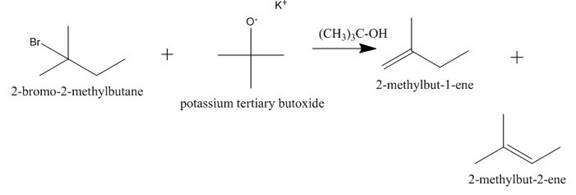
Explanation of Solution
The incomplete given reaction is shown below.

Figure 2
The given

Figure 3
The completed given reaction is shown in Figure 3.
(c)
Interpretation:
The given reaction is to be completed with principal organic products.
Concept introduction:
Oxymercuration reaction is a type of reaction in which an alkene gets converted to alcohol. The mercuric acetate is used in the reaction as a reagent. This reagent attacks the alkene to form a cyclic intermediate compound which further undergoes reduction to form alcohol.
Answer to Problem 11.60AP
The completed given reaction is shown below.
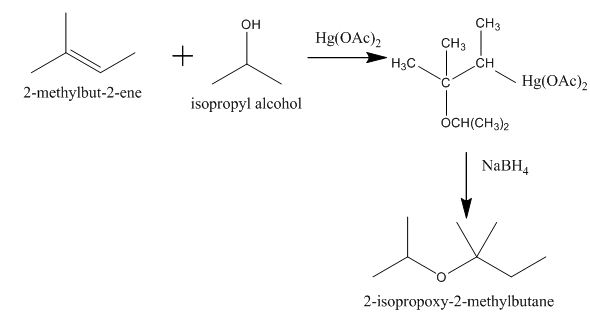
Explanation of Solution
The incomplete given reaction is shown below.

Figure 4
The mercuric acetate
The corresponding chemical reaction is shown below.

Figure 5
The completed given reaction is shown in Figure 5.
(d)
Interpretation:
The given reaction is to be completed with principal organic products. The stereochemistry of the product is to be predicted.
Concept introduction:
An
Answer to Problem 11.60AP
The completed given reaction is shown below.
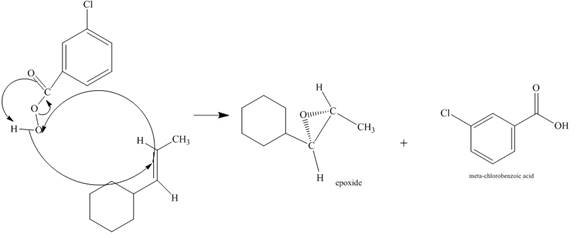
Explanation of Solution
The incomplete given reaction is shown below.
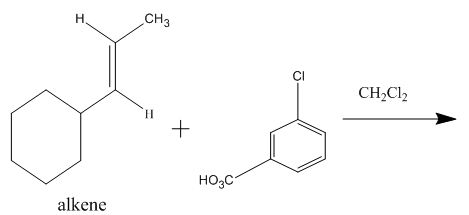
Figure 6
The alkene attacks on the peroxide linkage of the given percarboxylic acid to form an epoixde ring with elimination of carboxylic acid. The oxygen atom of the epoxide will be pointed inwards that is into the plane of the molecule. The corresponding chemical reaction is shown below.
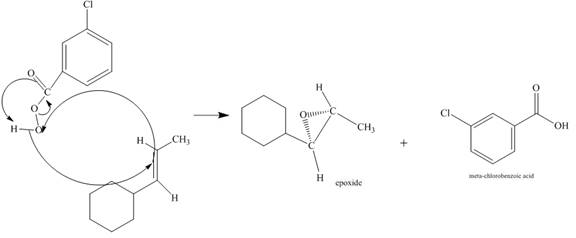
Figure 7
The completed given reaction is shown in Figure 7.
(e)
Interpretation:
The given reaction is to be completed with principal organic products.
Concept introduction:
The addition of one or more than one halogen atom in an alkene is known as halogenation reaction. The pathway of the halogenation reaction depends on the structure of the substrate. In this, the halogen is added to
The compound chromium
Answer to Problem 11.60AP
The completed given reaction is shown below.
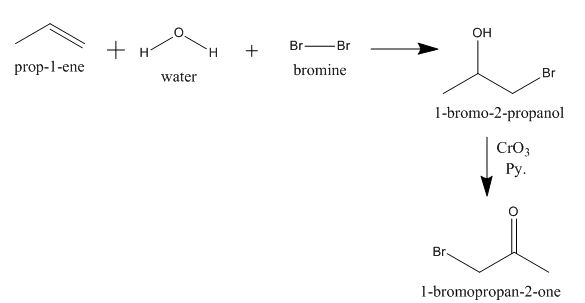
Explanation of Solution
The incomplete given reaction is shown below.
The propene molecule undergoes halohydrin reaction with bromine gas in the presence of water molecule to form bromine substituted alcohol. The alcohol gets oxidized by

Figure 8
The completed given reaction is shown in Figure 8.
(f)
Interpretation:
The given reaction is to be completed with principal organic products.
Concept introduction:
The periodic acid acts as a strong oxidizing agent. The periodic acid reacts with a vicinal diol to form two aldehyde after breaking the carbon-carbon bond between the vicinal diol. The gem diol does not react with periodic acid as vicinal diol.
Answer to Problem 11.60AP
The completed given reaction is shown below.
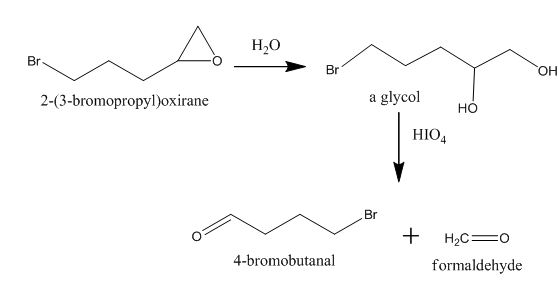
Explanation of Solution
The incomplete given reaction is shown below.

Figure 9
The epoxide is converted into gem diol after the addition of water in it. The gem diol gets converted into two different aldehydes after breaking the bond between carbon atoms attached to the hydroxyl group. The corresponding chemical reaction is shown below.

Figure 10
The completed given reaction is shown in Figure 10.
(g)
Interpretation:
The given reaction is to be completed with principal organic products. The stereochemistry of the product is to be predicted.
Concept introduction:
Potassium permanganate is a strong oxidizing agent. Potassium permanganate can oxidize an alkene into alcohol. It can also oxidize an alcohol into carbonyl compound and the carbonyl compound can be further oxidized to form a carboxylic acid.
Answer to Problem 11.60AP
The completed given reaction is shown below.

Explanation of Solution
The incomplete given reaction is shown below.

Figure 11
The oleic acid reacts with alkaline

Figure 12
The completed given reaction is shown in Figure 12.
(h)
Interpretation:
The given reaction is to be completed with principal organic products. The stereochemistry of the product is to be predicted.
Concept introduction:
Epoxides undergo nucleophilic ring-opening reactions which are acid-catalyzed. If the epoxide is unsymmetrical, then the anionic nucleophile will attack the less-hindered carbon atom of the ring. If the reaction conditions are basic or neutral, then the reaction will occur at the less substituted carbon atom.
Answer to Problem 11.60AP
The completed given reaction is shown below.

Explanation of Solution
The incomplete given reaction is shown below.

Figure 13
The compound epoxide undergoes ring-opening reaction in the presence of sodium azide. The azide ion acts a nucleophile and attacks on the carbon atom of the epoxide ring to from final compound. The corresponding chemical reaction is shown below.

Figure 14
The completed given reaction is shown in Figure 14.
(i)
Interpretation:
The given reaction is to be completed with principal organic products.
Concept introduction:
Epoxides undergo nucleophilic ring-opening reactions which are acid-catalyzed. If the epoxide is unsymmetrical, then the anionic nucleophile will attack the less-hindered carbon atom of the ring. If the reaction conditions are acidic, then the reaction will occur at the more substituted carbon atom.
Answer to Problem 11.60AP
The completed given reaction is shown below.

Explanation of Solution
The incomplete given reaction is shown below.

Figure 15
The ether undergoes ring-opening reaction in the presence of acid. The dilithium dimethylcyanocuprate molecule generates a nucleophile

Figure 16
The completed given reaction is shown in Figure 16.
(j)
Interpretation:
The given reaction is to be completed with principal organic products.
Concept introduction:
The replacement or substitution of one functional group with another different functional group in any chemical reaction is termed as a substitution reaction. In a nucleophilic substitution reaction, nucleophile takes the position of leaving group by attacking the electron-deficient carbon atom.
Answer to Problem 11.60AP
The completed given reaction is shown below.

Explanation of Solution
The incomplete given reaction is shown below.
The compound

Figure 17
The completed given reaction is shown in Figure 17.
(k)
Interpretation:
The given reaction is to be completed with principal organic products.
Concept introduction:
The replacement or substitution of one functional group with another different functional group in any chemical reaction is termed as a substitution reaction. In a nucleophilic substitution reaction, nucleophile takes the position of leaving group by attacking on the electron-deficient carbon atom.
Answer to Problem 11.60AP
The completed given reaction is shown below.

Explanation of Solution
The incomplete given reaction is shown below.

Figure 18
The replacement of the hydroxyl group is not easy. Therefore, alcohol is first converted into tosylate ester with the help of tosyl chloride. The tosylate ester group is then substituted with

Figure 19
The completed given reaction is shown in Figure 19.
Want to see more full solutions like this?
Chapter 11 Solutions
ORGANIC CHEMISTRY SAPLING ACCESS + ETEX
- Write the complete common (not IUPAC) name of each molecule below. Note: if a molecule is one of a pair of enantiomers, be sure you start its name with D- or L- so we know which enantiomer it is. molecule Ο C=O common name (not the IUPAC name) H ☐ H3N CH₂OH 0- C=O H NH3 CH₂SH H3N ☐ ☐ X Garrow_forward(Part A) Provide structures of the FGI products and missing reagents (dashed box) 1 eq Na* H* H -H B1 B4 R1 H2 (gas) Lindlar's catalyst A1 Br2 MeOH H2 (gas) Lindlar's catalyst MeO. OMe C6H1402 B2 B3 A1 Product carbons' origins Draw a box around product C's that came from A1. Draw a dashed box around product C's that came from B1.arrow_forwardClassify each of the amino acids below. Note for advanced students: none of these amino acids are found in normal proteins. X CH2 H3N-CH-COOH3N-CH-COO- H3N-CH-COO CH2 CH3-C-CH3 CH2 NH3 N NH (Choose one) ▼ (Choose one) S CH2 OH (Choose one) ▼ + H3N-CH-COO¯ CH2 H3N CH COO H3N-CH-COO CH2 오오 CH CH3 CH2 + O C CH3 O= O_ (Choose one) (Choose one) ▼ (Choose one) Garrow_forward
- Another standard reference electrode is the standard calomel electrode: Hg2Cl2(s) (calomel) + 2e2 Hg() +2 Cl(aq) This electrode is usually constructed with saturated KCI to keep the Cl- concentration constant (similar to what we discussed with the Ag-AgCl electrode). Under these conditions the potential of this half-cell is 0.241 V. A measurement was taken by dipping a Cu wire and a saturated calomel electrode into a CuSO4 solution: saturated calomel electrode potentiometer copper wire CuSO4 a) Write the half reaction for the Cu electrode. b) Write the Nernst equation for the Cu electrode, which will include [Cu2+] c) If the voltage on the potentiometer reads 0.068 V, solve for [Cu²+].arrow_forward2. (Part B). Identify a sequence of FGI that prepares the Synthesis Target 2,4-dimethoxy- pentane. All carbons in the Synthesis Target must start as carbons in either ethyne, propyne or methanol. Hint: use your analysis of Product carbons' origins (Part A) to identify possible structure(s) of a precursor that can be converted to the Synthesis Target using one FGI. All carbons in the Synthesis Target must start as carbons in one of the three compounds below. H = -H H = -Me ethyne propyne Synthesis Target 2,4-dimethoxypentane MeOH methanol OMe OMe MeO. OMe C₂H₁₂O₂ Product carbons' origins Draw a box around product C's that came from A1. Draw a dashed box around product C's that came from B1.arrow_forwardDraw the skeletal ("line") structure of the smallest organic molecule that produces potassium 3-hydroxypropanoate when reacted with KOH. Click and drag to start drawing a structure. Sarrow_forward
- draw skeletal structures for the minor products of the reaction.arrow_forward1. Provide missing starting materials, reagents, products. If a product cannot be made, write NP (not possible) in the starting material box. C7H12O Ph HO H 1) 03-78 C 2) Me₂S + Ph .H OH + 2nd stereoisomer OH Ph D + enantiomer cat OsO 4 NMO H2O acetonearrow_forwardPlease note that it is correct and explains it rightly:Indicate the correct option. The proportion of O, C and H in the graphite oxide is:a) Constant, for the quantities of functional groups of acids, phenols, epoxy, etc. its constants.b) Depending on the preparation method, as much oxidant as the graphite is destroyed and it has less oxygen.c) Depends on the structure of the graphic being processed, whether it can be more tridimensional or with larger crystals, or with smaller crystals and with more edges.arrow_forward
 ChemistryChemistryISBN:9781305957404Author:Steven S. Zumdahl, Susan A. Zumdahl, Donald J. DeCostePublisher:Cengage Learning
ChemistryChemistryISBN:9781305957404Author:Steven S. Zumdahl, Susan A. Zumdahl, Donald J. DeCostePublisher:Cengage Learning ChemistryChemistryISBN:9781259911156Author:Raymond Chang Dr., Jason Overby ProfessorPublisher:McGraw-Hill Education
ChemistryChemistryISBN:9781259911156Author:Raymond Chang Dr., Jason Overby ProfessorPublisher:McGraw-Hill Education Principles of Instrumental AnalysisChemistryISBN:9781305577213Author:Douglas A. Skoog, F. James Holler, Stanley R. CrouchPublisher:Cengage Learning
Principles of Instrumental AnalysisChemistryISBN:9781305577213Author:Douglas A. Skoog, F. James Holler, Stanley R. CrouchPublisher:Cengage Learning Organic ChemistryChemistryISBN:9780078021558Author:Janice Gorzynski Smith Dr.Publisher:McGraw-Hill Education
Organic ChemistryChemistryISBN:9780078021558Author:Janice Gorzynski Smith Dr.Publisher:McGraw-Hill Education Chemistry: Principles and ReactionsChemistryISBN:9781305079373Author:William L. Masterton, Cecile N. HurleyPublisher:Cengage Learning
Chemistry: Principles and ReactionsChemistryISBN:9781305079373Author:William L. Masterton, Cecile N. HurleyPublisher:Cengage Learning Elementary Principles of Chemical Processes, Bind...ChemistryISBN:9781118431221Author:Richard M. Felder, Ronald W. Rousseau, Lisa G. BullardPublisher:WILEY
Elementary Principles of Chemical Processes, Bind...ChemistryISBN:9781118431221Author:Richard M. Felder, Ronald W. Rousseau, Lisa G. BullardPublisher:WILEY





